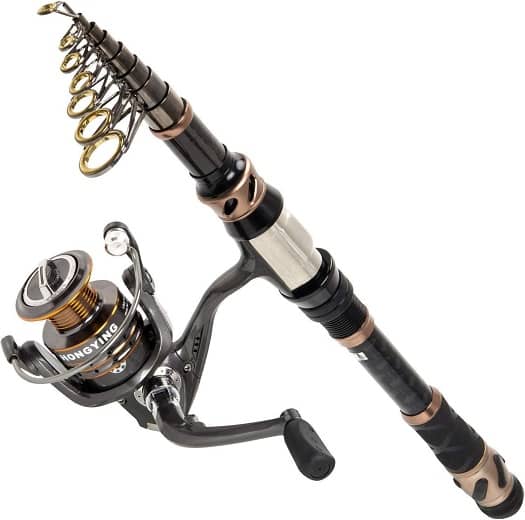
Telescopic fishing rods offer anglers the convenience of portability and ease of storage. Understanding the materials used in telescopic fishing rods is crucial for selecting the right rod that suits your fishing style and preferences. In this comprehensive guide, we will delve into the various materials commonly used in telescopic fishing rods, exploring their pros and cons in terms of weight, cost, strength, sensitivity, and flexibility.
Fibreglass
Fibreglass is a popular material, especially for beginners or anglers on a budget. They are known for their durability, flexibility, and resistance to bending or breaking under pressure. They are also more affordable compared to other materials.
Pros
- Affordability: Fibreglass rods are often more budget-friendly compared to other materials.
- Durability: Fibreglass is known for its strength and resistance to breakage, making it suitable for heavy-duty fishing.
- Forgiveness: Fibreglass rods have a forgiving nature, absorbing shocks from sudden movements by fish.
Cons:
- Weight: Fibreglass rods tend to be heavier than other materials, which can affect the balance and overall feel during long casting sessions.
- Sensitivity: Fibreglass is generally less sensitive than materials like carbon fibre/graphite, making it challenging to detect subtle bites or vibrations.
Carbon Fibre/Graphite
Carbon fibre or graphite is a lightweight and strong material widely used in high-quality collapsible fishing rods. They offer increased sensitivity, allowing anglers to feel even subtle fish bites or movements. They provide excellent strength-to-weight ratio, responsiveness, and casting accuracy.
Pros
- Lightweight: Carbon fibre/graphite rods are significantly lighter than fibreglass, reducing fatigue during long fishing sessions.
- Sensitivity: Carbon fibre/graphite is highly sensitive, allowing anglers to detect even the slightest fish bites or movements.
- Strength-to-Weight Ratio: These rods offer an excellent strength-to-weight ratio, providing both strength and responsiveness.
Cons
- Cost: Carbon fibre/graphite rods are often more expensive compared to fibreglass rods.
- Brittle: While carbon fibre/graphite is strong, it can be more brittle than other materials, making it more susceptible to breakage under extreme pressure or impacts.
Composite Blends
Some telescopic fishing rods utilise a combination of materials to create composite blends. These blends often involve a mix of carbon fibre/graphite and fibreglass. The combination aims to provide the benefits of both materials, offering a balance of strength, flexibility, and sensitivity.
Pros
- Versatility: Composite blends combine the benefits of different materials, offering a balance of strength, flexibility, and sensitivity.
- Customisation: Manufacturers can tailor the composition of composite blends to achieve specific performance characteristics.
Cons
- Cost: Composite blend rods may be more expensive due to the use of multiple materials and complex manufacturing processes.
Carbon Composite
Carbon composite rods are another common option in extendable rods. They blend carbon fibre with other reinforcing materials to enhance durability and strength. Carbon composite rods offer a good compromise between sensitivity and affordability.
Pros
- Strength and Durability: Carbon composite rods provide enhanced strength and durability, making them suitable for various fishing environments.
- Sensitivity: These rods offer good sensitivity, allowing anglers to feel subtle fish strikes.
Cons
- Cost: Carbon composite rods tend to be more expensive than fibreglass rods, but they are often more affordable than full carbon fibre/graphite rods.
Stainless Steel (Guides)
Stainless steel is commonly used for the guides or line guides of telescopic fishing rods. Guides play a crucial role in guiding the fishing line smoothly and preventing it from tangling or snagging. Stainless steel guides are corrosion-resistant, durable, and can handle the demands of different fishing environments.
Pros
- Corrosion Resistance: Stainless steel guides are highly resistant to corrosion, ensuring long-term durability and smooth line movement.
- Durability: Stainless steel guides can withstand the demands of different fishing environments.
Cons
- Weight: Stainless steel guides may add some weight to the overall rod.
Summary
It’s important to note that the specific material used in a collapsible rod can vary depending on the manufacturer, model, and price range. Higher-end options often incorporate more advanced and lighter materials, while budget-friendly options may use more basic materials. When choosing one, it’s essential to consider your fishing needs, preferences, and budget to select the material that best suits your requirements.
Fibreglass offers affordability and durability but sacrifices some sensitivity. Carbon fibre/graphite rods provide excellent sensitivity and lightweight design, but at a higher cost. Composite blends offer versatility but may come at a higher price point. Carbon composite rods strike a balance between strength and affordability. Stainless steel guides contribute to durability but add some weight.
Ultimately, the right material for your telescopic fishing rod depends on your budget, fishing style, target species, and personal preferences. Consider the pros and cons outlined in this guide to make an informed decision and enhance your fishing experience.
